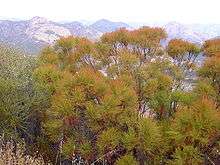Adenostoma sparsifolium
Adenostoma sparsifolium, commonly known as redshanks or less commonly, ribbonwood or ribbon bush, is a multi-trunked tree or shrub native to dry slopes or chaparral of Southern California and northern Baja California.
| Adenostoma sparsifolium | |
|---|---|
 | |
| Scientific classification | |
| Kingdom: | Plantae |
| Clade: | Tracheophytes |
| Clade: | Angiosperms |
| Clade: | Eudicots |
| Clade: | Rosids |
| Order: | Rosales |
| Family: | Rosaceae |
| Genus: | Adenostoma |
| Species: | A. sparsifolium |
| Binomial name | |
| Adenostoma sparsifolium | |
Description
Shaggy falling shanks or ribbons of bark are one of the strongest characteristics of the Adenostoma sparsifolium tree, hence the common names. As the species name "sparsifolium" suggests, it has tiny, filamentous leaves. Redshanks are closely related to the more abundant Chamise (Adenostoma fasciculatum).
Ecology
Redshanks inhabits higher elevations of chaparral just above and below the snowline in the Peninsular Ranges and does best on north-facing "ubac" slopes at around 4,000 feet of elevation. Associates at its lower range include California Scrub Oak and Hoary Ceanothus, and mingles with manzanitas at its upper range.
Like its relative, chamise, it is capable of resprouting after a fire.
References
- Blanchan, Neltje (2005). Wild Flowers Worth Knowing. Project Gutenberg Literary Archive Foundation.
- Schoenherr, Allan A. (1992). A Natural History of California. University of California Press.
External links
![]()
![]()